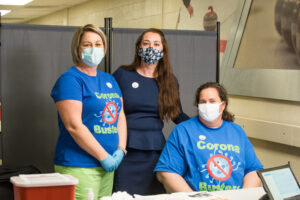
Dr. Maria Maguire (center), with nurse Carie Eader (left) and Stacy Miller (right).
Gov. Larry Hogan urged patience at his press conference on Tuesday, Jan. 5, while also announcing measures to speed up the deployment of the COVID-19 vaccine. Acting Health Officer Dr. Maria Maguire echoes his advice, while also stressing that Talbot County’s plan is well underway.
The Talbot County Health Department has already begun giving COVID-19 vaccines to healthcare providers and others on the frontline of the public health crisis. Health Department staff are currently vaccinating first responders and have arranged vaccine clinics at private medical practices as the first line of defense, or “vaccinating the vaccinators,” as Hogan explained.
While doses of the vaccine are still limited in Talbot County, Dr. Maguire says the Health Department has a solid plan for distributing the vaccine. “Implementation is the most important piece,” she explains. “We have worked hard to make sure our plan is both efficient and effective.”
For more about Talbot County’s vaccination plan, check out our recent Q&A with Dr. Maguire.
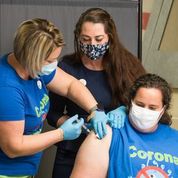 How many vaccines has Talbot County received and what is the plan for deploying them?
How many vaccines has Talbot County received and what is the plan for deploying them?
As of Wednesday, the Talbot County Health Department has received 1,100 doses of the Moderna COVID vaccine, though other facilities such as nursing homes and hospitals are receiving Pfizer vaccines. By the end of the week, we are on track to have administered more than 600 doses of these vaccines, and we also have clinics scheduled for next week at which the remaining 500 doses will be administered.
We are using those doses to vaccinate individuals in the “1A” priority group, which includ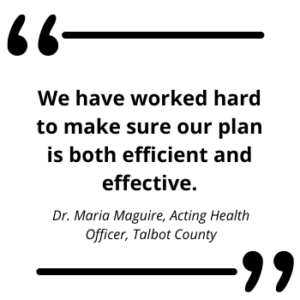 es all first responders, vaccinators, and healthcare providers. Additionally, we have vaccinated law enforcement, firefighters, EMS, 911 dispatch workers, correctional staff and officers, and frontline judiciary staff in Phase 1A.
es all first responders, vaccinators, and healthcare providers. Additionally, we have vaccinated law enforcement, firefighters, EMS, 911 dispatch workers, correctional staff and officers, and frontline judiciary staff in Phase 1A.
Any healthcare provider who is licensed, registered, or certified by a Maryland health occupation board or the Maryland Department of Health is eligible to receive a COVID vaccine in the Phase 1A grouping. Healthcare workers will be asked to provide proof of licensure or employment verification such as a work badge or ID to verify eligibility for the Phase 1A category.
After we have offered vaccines to all eligible recipient groups in Phase 1A, we will proceed to Phase 1B and continue with the established priorities. I anticipate we will complete our 1A phase by January 15. The number of clinics and vaccines we can administer, of course, is entirely dependent on the number of vaccine doses we receive each week, which is highly variable at this point. Our goal is to get as many people vaccinated as quickly as possible while adhering to the risk-based prioritization plan.
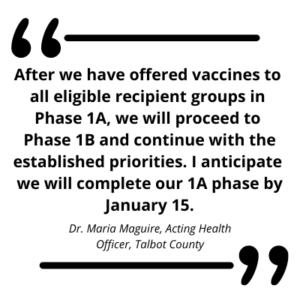 Where are the vaccines being given?
Where are the vaccines being given?
These initial vaccinations are being administered at closed vaccine clinics. Eligible recipients are invited to register for an appointment, and our vaccination staff coordinates the time and location with the recipients. For some of these clinics, we go to the recipients in order to maximize convenience, but we are also hosting mass clinics where eligible participants from a number of organizations may be vaccinated.
After we enter Phase 1B, we will start hosting vaccination clinics that are open to the public. The majority of those clinics will take place at a drive-thru location in Easton, though we are also planning clinics in other locations in the county and even a mobile clinic we expect to roll out in early spring.
How do I sign up to receive my vaccination?
Everyone who receives a COVID vaccine will need to register through the state “PrepMod” 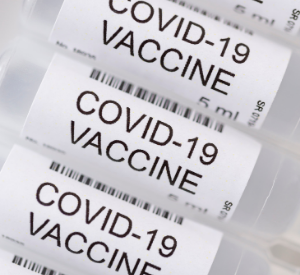 registration system. This is an online, cloud-based system that allows for easy scheduling and tracking of when and where doses are administered.
registration system. This is an online, cloud-based system that allows for easy scheduling and tracking of when and where doses are administered.
For Phase 1A recipients, they are directly emailed the registration link by the health department. When we are in Phase 1B and may start hosting vaccine clinics for members of the public, a registration link will be publicized widely to the target audience.
For example, the first tier of individuals we plan to vaccinate in the Phase 1B category is adults who are 75 years old and older. We will share the registration link widely to the public when those clinics have been scheduled so that individuals may sign up on their own. The best place to look for the most up to date information on the COVID vaccination process is the talbotcovid19.org website and Facebook feeds.
Knowing that not everyone has easy access to a computer, internet, or an email address, we will also have a call center and will work with community partners to help individuals register. In addition, we will also allow “walk-ins” so that people may register on site. However, this will be again dependent on vaccine supply. That last thing I want to happen is for anyone to be turned away from a vaccine clinic because of a lack of vaccine supply.
How will homebound residents get a vaccine?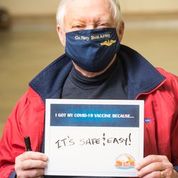
We are actively coordinating this now in preparation for when these residents will be eligible. Fortunately, we have a wonderful Senior Care program in the health department, and they are able to go to individuals’ homes to administer vaccinations. We are also working with community partners to help identify members of these vulnerable populations so that no one is missed.
Who should be concerned about taking the vaccination?
Because COVID vaccines are new, many people understandably have questions about whether they are safe or whether they should get one. These vaccines have gone through rigorous studies and reviews to ensure not only safety, but effectiveness.
The accelerated timeline to develop these vaccines was possible because so many resources were directed at these programs, and many steps which usually happen consecutively in vaccine development were able to occur in parallel or simultaneously. Absolutely no corners were cut.
Tens of thousands of people enrolled in each of the Pfizer and Moderna trials, and, as of today, more than 5.46 million Americans and 15.9 million people in 37 different countries have received one of these vaccines.
Extraordinarily few adverse events have been reported — literally, of the 5.46 million Americans vaccinated to date, only 49 have had a serious reaction, and all were resolved with appropriate medical treatment. The most common serious reaction is anaphylaxis, which has occurred in 28 people, according to the CDC today.
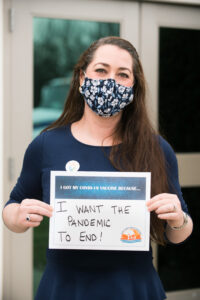 This is why anyone with a history of a severe allergic reaction to an ingredient in the vaccine should not get a COVID vaccine, and this applies to very few people. However, considering that nearly 360,000 people have died of COVID-19 to date, for me it was a very easy calculation. When I was offered the vaccine, I eagerly signed up to receive it as soon as possible.
This is why anyone with a history of a severe allergic reaction to an ingredient in the vaccine should not get a COVID vaccine, and this applies to very few people. However, considering that nearly 360,000 people have died of COVID-19 to date, for me it was a very easy calculation. When I was offered the vaccine, I eagerly signed up to receive it as soon as possible.
The main side effect for me has been a new sense of hope and, quite frankly, less guilt as a healthcare provider of bringing COVID home to my unvaccinated family. If anyone has concerns or questions, they should reach out to their regular medical provider to discuss the benefit of getting vaccinated and look for helpful resources both at covidLINK Maryland and the CDC.
Additional information about Talbot County’s vaccination program can be found at TalbotCOVID19.org or on Facebook at TalbotCOVID-19. For statewide information, visit covidlink.maryland.gov or text MDReady to 898211.